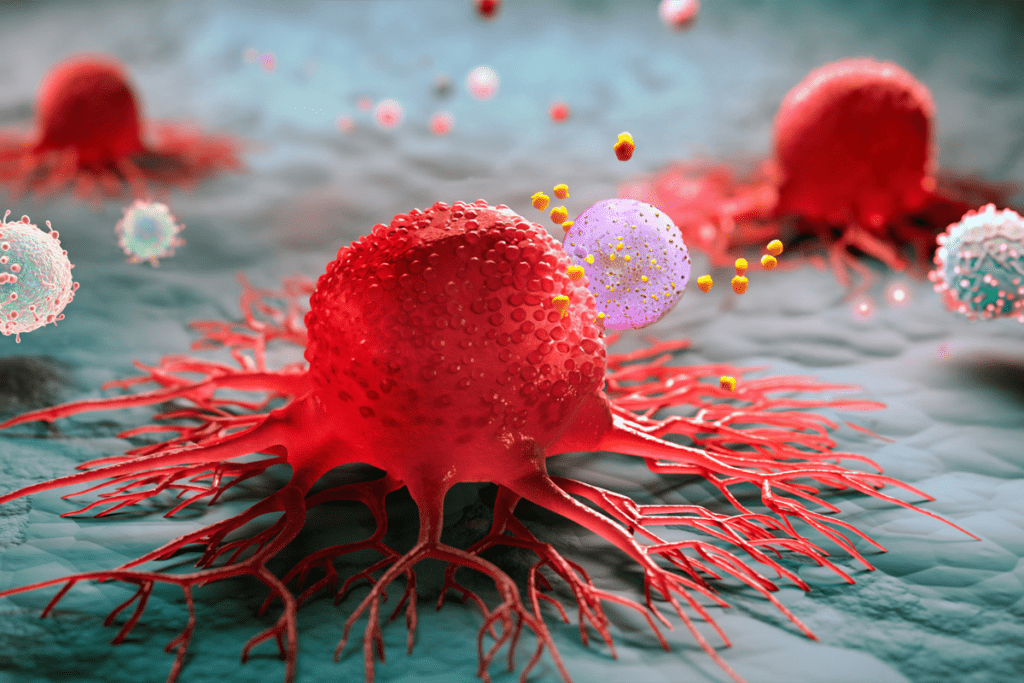Last Updated on October 21, 2025 by mcelik
If treatment fails, what’s next? We discuss follow-up options and alternative therapies after stopping immunotherapy due to side effects or lack of efficacy.
When immunotherapy failure happens, patients and doctors need to look at other cancer treatments fast. Dealing with cancer treatment is tough, even when the first steps don’t work.
At this important time, looking at other options is key. We talk about chemotherapy, targeted therapy, radiation, and clinical trials. Our aim is to give a full view of what’s next and help you make smart choices about your treatment.

To know if immunotherapy is working, we do several tests and evaluations. We check how the cancer reacts to the treatment. This helps us decide what to do next.
Disease progression can show up in different ways during immunotherapy. We watch for signs like new tumors or growth in existing ones. Imaging tests like CT or PET scans are key in spotting these changes.
These scans compare the cancer before and after treatment. They show if the treatment is working. If the cancer is getting worse, we look for other treatments.
It’s important to remember that immunotherapy doesn’t work for everyone. We consider many factors when choosing the next treatment. These include the cancer type, overall health, and past treatments.

We usually check if immunotherapy is working after a few months. Imaging tests are done around three months into treatment. This lets us see if the treatment is effective or if we need to try something else.
We compare scans from before and during treatment. If the cancer is shrinking or staying the same, we might keep the current treatment. But if it’s growing, we talk about other options. These could include chemotherapy, targeted therapy, or clinical trials.
This process is complex and requires careful monitoring. Our aim is to find the best treatment while keeping the patient’s quality of life in mind.
When cancer grows despite immunotherapy, standard chemotherapy is often next. Chemotherapy has been a key part of cancer treatment for years. It offers many options for different cancers.
Chemotherapy targets fast-growing cells, like cancer cells. It’s not as precise as immunotherapy but can slow cancer growth.
Research shows that patients with non-small cell lung cancer (NSCLC) who didn’t respond to immunotherapy can live 9.8 to 11.8 months with chemotherapy. These results highlight chemotherapy’s role in treatment.
The success of chemotherapy depends on several things. These include the cancer type, past treatments, and the patient’s health. Knowing these factors helps choose the right chemotherapy.
The choice of chemotherapy after immunotherapy failure depends on several factors. These include the cancer type and past treatments. Common chemotherapy agents include:
These agents can be used alone or together, depending on the situation. For example, a mix of platinum-based and taxane might be used for NSCLC.

It’s important for patients to talk to their healthcare provider. This helps choose the best chemotherapy for their situation.
For patients who don’t get better with immunotherapy, targeted therapy is a hopeful option. It’s based on the genetic changes in their cancer cells. Targeted therapy is a big step in cancer treatment. It gives a more personal approach by focusing on the tumor’s specific genetic traits.
Tyrosine kinase inhibitors (TKIs) work well for non-small cell lung cancer (NSCLC) with certain mutations. These mutations make cancer cells more open to treatment. For example, EGFR mutations in NSCLC can be targeted with specific TKIs.
Matching treatments to molecular profiles involves detailed genetic testing. This finds the mutations in a patient’s cancer. Then, the right targeted therapy is chosen. Molecular profiling is key in modern cancer care. It helps doctors tailor treatments for each patient.
Understanding the genetic mutations behind a patient’s cancer helps doctors offer better treatments. Targeted therapy, including TKIs for NSCLC patients, is a big leap in cancer care.
When immunotherapy doesn’t work, radiation therapy is key for local control. We use it to focus on areas where cancer has spread. This helps control tumor growth and gives relief.
Stereotactic Body Radiation Therapy (SBRT) is a precise way to treat cancer. It gives high doses of radiation to small tumors. SBRT works best for tumors that haven’t spread to other parts of the body.
This method is precise, aiming to hit the tumor without harming nearby healthy tissues. This reduces side effects.
Palliative radiation therapy helps manage symptoms like pain, bleeding, or blockages. It targets the source of these symptoms, improving life quality for those with advanced cancer. We often treat bone metastases with it to reduce pain and fracture risk.
Radiation therapy offers many benefits in cancer care. It helps control tumors and manage symptoms. Whether it’s SBRT for precise targeting or palliative radiation for symptom relief, it’s a vital part of cancer treatment.
Doctors must look for other treatments when immunotherapy causes severe side effects. Immunotherapy is effective against many cancers but comes with risks. Some patients face side effects that harm their quality of life.
It’s key to manage immune-related adverse events to keep patients’ quality of life good. These events can be mild or severe, affecting things like energy, skin, and organs. Early detection and treatment are vital to avoid lasting harm.
Stopping immunotherapy due to side effects is a personal decision. Doctors consider the side effect’s severity, the patient’s health, and treatment success. If side effects are severe and can’t be managed, stopping treatment might be needed.
Doctors weigh the risks and benefits of continuing or stopping immunotherapy. If the risks are too high, stopping treatment could be the best choice.
Keytruda (pembrolizumab) is a common immunotherapy drug. Treatment length with Keytruda varies based on cancer type, response, and side effects. Patients usually get Keytruda for up to 2 years or until significant side effects or disease progression occur.
It’s important for patients to talk to their healthcare provider about treatment options and side effects. Understanding the risks and benefits helps patients make informed decisions about their care.
When standard treatments don’t work, clinical trials offer a chance to try new treatments. These studies test the safety and effectiveness of new treatments. This can include new medicines, therapies, or other approaches.
New trial arms in clinical trials are showing great promise. They have led to patients with non-small cell lung cancer (NSCLC) living up to 24.5 months longer. This is a big improvement over older treatments.
The progress in new trial arms comes from new ideas. These include combining immunotherapy and targeted therapies. For example, some studies show that certain combinations can boost the immune system’s fight against cancer. This leads to better results for patients.
Bispecific T-cell engagers (BiTEs) are also being researched for small cell lung cancer. BiTEs are a form of immunotherapy. They aim to get T cells to target and destroy cancer cells more effectively. Early trial results are promising, giving hope to those with this tough disease.
In summary, clinical trials are a key way for patients to try new treatments. By joining these trials, patients can get treatments that might not be available elsewhere. They also help advance medical science.
When immunotherapy doesn’t work, combining treatments can be a good option. We look at different ways to make treatments better.
Chemoimmunotherapy mixes chemotherapy with immunotherapy. It has shown great promise. This mix can lead to response rates up to 88.9% in some cancers.
“The mix of chemotherapy and immunotherapy has changed how we treat cancer,” studies say . This combination can improve patient results.
Some cancers do better with combination treatments. Melanoma and Hodgkin lymphoma see big improvements with chemoimmunotherapy. Knowing the cancer’s molecular details helps tailor treatments.
For those who fail chemotherapy, immunotherapy can be a next step. The choice depends on the patient’s health and cancer type.
By looking at these factors, we can pick the best treatment order. Leading expert said, “Understanding how therapies work together and the cancer’s biology is key to success.”
“The future of cancer treatment is not just about new therapies, but also combining and sequencing them well.”
” Expert Oncologist
We keep working on combining treatments to help patients more. By leading in research and practice, we can offer the best treatments.
Dealing with cancer treatment can be tough, even when immunotherapy doesn’t work. Knowing about other options like chemotherapy, targeted therapy, and clinical trials helps. This way, patients can make informed decisions about their care.
We’ve looked at what to do when immunotherapy stops working. It’s key for patients to talk to their doctors about their options. This way, they can find the best next treatment step together. This team effort makes sure patients get care that fits their needs.
Working with their healthcare team, patients can choose treatments that match their goals. This partnership is vital in overcoming cancer treatment challenges. It helps patients get the best results possible.
If immunotherapy stops working, doctors might try other treatments. This could be chemotherapy, targeted therapy, or radiation therapy. The choice depends on the cancer type and past treatments.
Doctors use CT or PET scans to check how well treatment is working. They compare scans before and after 3 months. This shows if the cancer is shrinking, staying the same, or growing.
Signs of disease progression include bigger tumors or new ones on scans. Doctors also look at symptoms and overall health.
How long you stay on Keytruda depends on your cancer and how you respond. Doctors will decide based on regular checks.
The chemotherapy used depends on the cancer type and past treatments. Doctors might choose different options, including combinations.
Targeted therapy is based on the tumor’s genetics. For NSCLC with certain mutations, TKIs are effective. Treatments are matched to the tumor’s profile for better options.
Radiation therapy is a key tool in cancer care. It offers precise treatments like SBRT for small tumors. It also helps manage symptoms like pain.
Clinical trials offer new treatments not available elsewhere. Recent studies show improved survival rates for NSCLC patients in new trial arms.
Chemoimmunotherapy combines chemotherapy and immunotherapy. It has shown high response rates in cancers like melanoma and Hodgkin lymphoma. It’s also being tested in different treatment sequences.
Managing side effects is key to quality of life. Doctors decide when to stop treatment due to side effects. They also guide on managing these issues.
Bispecific T-cell engagers are being tested in clinical trials, mainly for small cell lung cancer. They are a promising area in cancer treatment, opening new possibilities.
Subscribe to our e-newsletter to stay informed about the latest innovations in the world of health and exclusive offers!